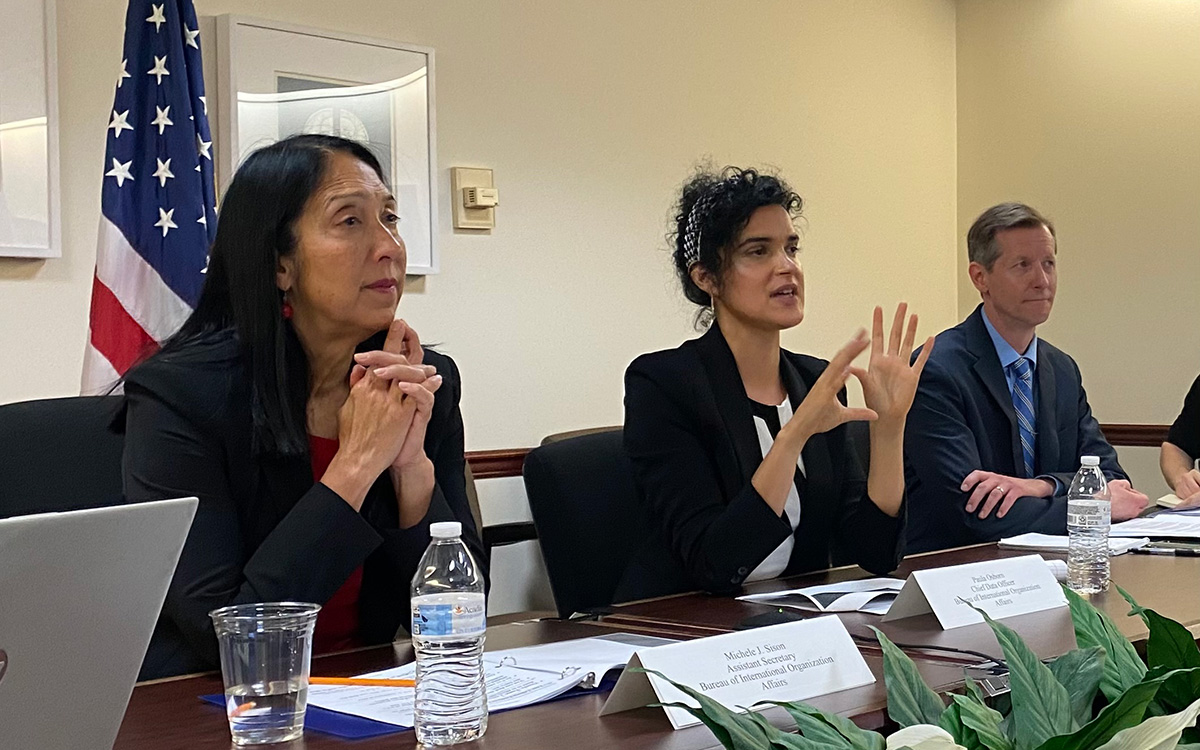Toward Data-Informed Multilateral Diplomacy
Here is a case study of the adoption of AI and data science in the Bureau of International Organization Affairs.
BY PAULA OSBORN

IO Assistant Secretary Michele Sison (left), Chief Data Officer Paula Osborn, and Deputy Assistant Secretary Brian Grimm spoke at the Secretary’s Open Forum on “Driving Strategic Multilateral Diplomacy Through Data” on June 8, 2023.
Courtesy of Paula Osborn
In the rapidly changing geopolitical landscape that the United States faces today, using data analysis and artificial intelligence (AI) to efficiently analyze information and patterns, anticipate potential crises, and understand public sentiment will be critical for all diplomats.
I work in the Bureau of International Organization Affairs (IO), and we are especially excited about the new possibilities AI brings and have specifically prioritized bringing data science into the art of diplomacy to advance national interests at the United Nations (U.N.) and other multilateral organizations. Leveraging data is particularly important to IO because the U.N. is the public messaging forum for global strategic competition in diplomatic matters. However, effectively integrating new technology into a legacy organization faces significant hurdles. Fostering a culture that embraces AI technology, particularly the modernization of AI infrastructure, is challenging.
Utilizing the Data and AI
There are numerous ways in which the State Department can utilize data and AI to bolster our diplomatic efforts; three will be outlined here, as well as obstacles the department faces to achieving these desired end-states.
Future State of Diplomacy 1: Employing data and AI to enable diplomats to spend more time on core diplomatic functions.
Limited resources and increased policy mandates have left diplomats with less time for strategic thinking and international collaboration. Effective data tools, particularly those focused on the automation of routine tasks, can reclaim much of this lost time. In 2023, IO saved more than 600 labor hours and improved data quality by partially automating the quantitative portion of an annual congressional report on U.S. government financial contributions to international organizations. Currently, IO is also working on other automation efforts, including for communications, clearances, and public affairs activities to free up time for high-value diplomatic work that is not easily replicated by machines.
In addition to automation, dashboards—visual interfaces that display important data points—help supercharge the work of our modern diplomats. Well-crafted dashboards enable easy data sharing and analysis of real-time information in a consolidated, user-friendly format, saving time across working levels. The Bureau of International Organization Affairs has developed multiple dashboards, including those related to U.N. financial contributions and personnel, voting coincidence, peacekeeping, and more. These dashboards live on the IO Multilateral Data Center (a website internal to the department) and are available to all department staff. To date, they have been used effectively by overseas posts, IO’s missions to international organizations, and U.S. participants at the most recent U.N. General Assembly High Level Week.
Generative language tools, such as ChatGPT, use AI to generate human-like text in response to input. Diplomats can save countless hours by using ChatGPT and similar tools for first-draft writing of speeches, memos, cables, and other department documents. These tools are currently available for unclassified material but can be used for anything sensitive once they are approved for internal department use (one of many AI infrastructure approval difficulties detailed a little later).
When diplomats use tools such as ChatGPT, it remains crucial that they critically review and refine the AI-generated drafts, ensuring that these reflect the nuanced understanding and strategic objectives unique to human diplomacy. Without this human review, the AI text may miss important reference material or provide incorrect information (known as an AI hallucination). Addressing big global challenges, meeting with foreign counterparts, representing U.S. interests and policies at international forums, negotiating treaties and resolutions, promoting positive relations and international cooperation between the United States and foreign countries, and fulfilling other core diplomatic functions cannot be replicated by machines. However, using AI can save time and enable diplomats to focus on the high-value work of diplomacy.
Future State of Diplomacy 2: Maintaining our global strategic advantage over competitors.
International challenges of today are often first addressed at the U.N., making it an enticing forum for our global competitors to actively engage in influence campaigns that run contrary to U.S. foreign policy goals. Effectively countering these influence campaigns and promoting democratic interests are crucially important. Advanced analytics and AI can allow the department to pinpoint where the United States should invest in strategic alliances and identify like-minded groups in the international fora, helping us build cohesion and coordinate voting.
At IO, we have used AI to develop an application to review draft U.N. resolutions for problematic language that would undermine U.N. principles. This functionality will save staff countless hours that would otherwise be spent manually finding and flagging language contrary to U.S. interests; it also increases the accuracy of identifying existing and emerging problematic language.
In addition, data helps us be more persuasive. Sharing dashboards demonstrating trends over time or identifying patterns enables us to get complex points across quickly with partners. Citing statistics in speeches garners trust from listeners. Refuting objective data is challenging, and the development and use of data and AI-enabled tools is a powerful communications instrument for any organization. Incorporating data into the talking points and public messaging of our U.N. representatives not only strengthens our arguments but also positions us as a credible and authoritative voice.
Leveraging data is particularly important to IO because the U.N. is the public messaging forum for global strategic competition in diplomatic matters.
Future State of Diplomacy 3: Making more tactical decisions.
To be clear, data tools are not here to replace information the State Department gets from our counterparts in the field, subject matter experts, or advisers. Instead, such tools work in concert with all these resources as they provide enhanced visibility into complex data sets and allow for improved analysis to be effectively combined with information from experts in the field. Data on how a particular country voted on U.S.-sponsored U.N. resolutions over time may help inform our decision to support a future resolution sponsored by that country. Data on which international organizations a particular government funds indicates their strategic interests and helps inform how we should prioritize engagement with that government.
Similarly, IO is expanding its investment in more tactical and strategic decision-making regarding démarches—formal diplomatic requests to persuade or inform host-nation governments on a given subject. In collaboration with State’s Center for Analytics, IO engaged in the first analysis of State’s largest corpus of internal data—cables. A study on recent démarches indicated that the quality of the outcome information received from post in “démarche delivered” cables was too poor to enable measurement of statistically significant results. IO is currently working on ways to improve démarche response data quality to improve future U.N. vote tracking.
Challenges
Fully and effectively incorporating data tools into the State Department’s diplomatic efforts will require hard work. First, we need more internal data expertise dedicated to the development of AI-enabled data tools. Data science is a very specialized skill set, and experienced practitioners are in constant demand and command high salaries. According to Glassdoor, the average salary for an entry-level data scientist in 2023 was $113,894 per year, which is above a Washington, D.C., localized GS-13 pay rate.
In late 2021, the Center for Analytics brought the Office of Personnel Management’s data scientist occupational series to State, making it easier to hire for this specialized job. The following year, the center partnered with the Bureau of Global Talent Management to create chief data officer positions in the various bureaus at State, with the first cohort onboarded in 2023. These personnel have technical data backgrounds and serve as in-house experts who oversee data-based projects and drive innovation in concert with wider department data-focused initiatives.
As one of the pilot bureaus for this program, IO has made the intentional decision to dedicate a GS-15 and a GS-14 Civil Service position for a chief data officer and deputy. In addition to these Civil Service positions, IO relies on a contract team of data scientists to build its data program, from the foundational data infrastructure, management, and governance to its advanced analytics and AI tools. Contract staff enable IO to add and remove different data skill sets quickly, but direct-hire employees are critical for institutional knowledge, are more cost-effective, and provide long-term commitment.
The State Department also needs robust data infrastructure, including cutting-edge software and servers, to give data scientists the computing power necessary to extract valuable insights. Unfortunately, approving needed software within the department can be a long process because of security concerns and other bureaucratic issues. This bottleneck greatly constrains the effectiveness of all data work currently underway at State. The number-one complaint I have received from my data scientists, both at the Center for Analytics and IO, is how long it takes to get software approved and what a big impediment this is to doing their jobs. Not having access to the correct tools is akin to asking a chef to cook a gourmet meal without kitchen appliances. Of course, security is a top priority for the department, but there needs to be a balance between an extremely lengthy process to get software approved and the necessity of creating cutting-edge AI-enabled data tools to bolster our national security.
Another significant barrier to data-informed diplomacy is user adoption. “I’m not a numbers person” is a statement I frequently hear from foreign affairs experts. But the reality is that times are changing and, frankly, we are already behind. Everyone should be confident with the numbers behind important metrics for their bureaus, and the mandate to familiarize oneself with relevant data must come from the top.
In IO, Assistant Secretary Michele Sison requires data attachments in all meeting preparation papers written for her by staff. Principal Deputy Assistant Secretary Dave McFarland attends every single IO data training and event, introducing each with brief remarks on the bureau’s commitment to building and fostering a culture of evidence-informed diplomacy. Deputy Assistant Secretary Brian Grimm always carries around multiple copies of our U.N. Security Council Snapshots (please ask him for one if you see him), which he hands out in meetings. Most of the IO front office has the IO Multilateral Data Center hyperlinked in their email signatures. These are just a few examples of how IO leadership emphasizes the importance of data, which signals to the bureau their need to prioritize data as well. This prioritization is critical for data and AI to succeed in making cultural inroads at State.
There are many challenges on the road to effectively using data and AI, particularly at an organization as large and established as the State Department. However, in a rapidly evolving global landscape marked by complex challenges and competitive pressures, using AI-enabled data tools is not only a strategic imperative but a critical transformative step toward enhancing the effectiveness of our diplomatic efforts. The vision for a data-informed future state of diplomacy hinges on successfully navigating talent acquisition and development, resource allocation, data infrastructure and prioritization, and forward-thinking leadership.
A commitment to innovation positions data and AI as fundamental pillars in shaping the future of diplomacy, the U.S.’s global position, and our national security posture.
When sharing or linking to FSJ articles online, which we welcome and encourage, please be sure to cite the magazine (The Foreign Service Journal) and the month and year of publication. Please check the permissions page for further details.
Read More...
- “Diplomacy in Cyberspace” by Chris Painter, The Foreign Service Journal, June 2018
- Data Informed Diplomacy, U.S. Department of State Office of Management Strategy and Solutions
- “Leveraging generative artificial intelligence to outcompete strategic rivals” by Jeffrey Cimmino and Andrew A. Michta, The Atlantic Council, March 2024






